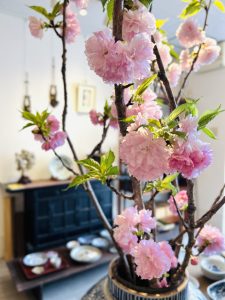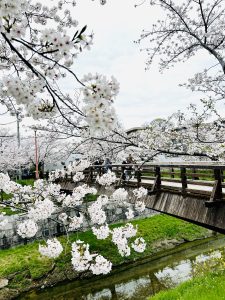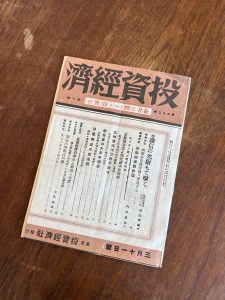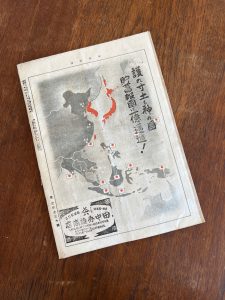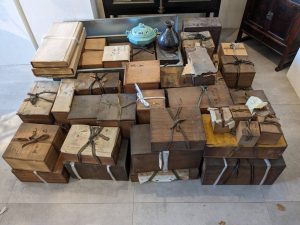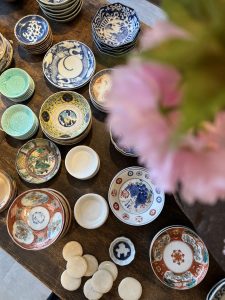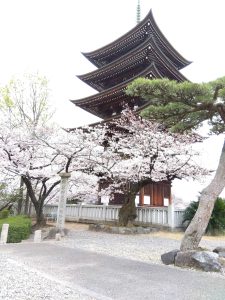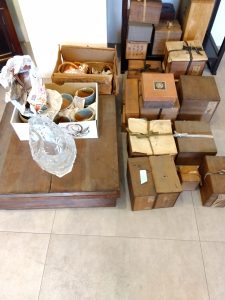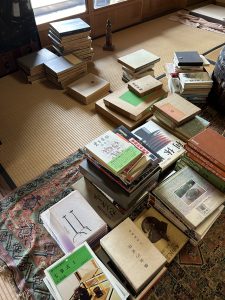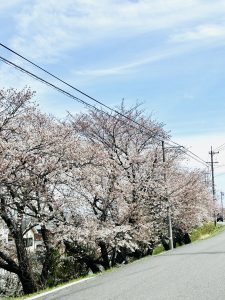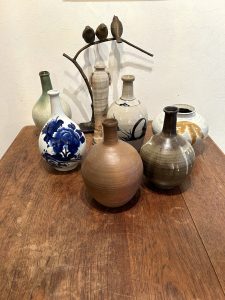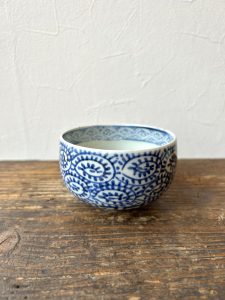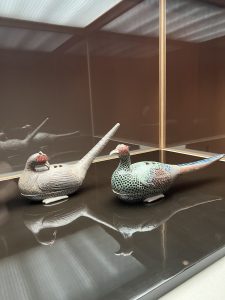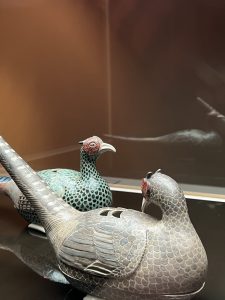新入学おめでとうございます🌸(愛知県名古屋市千種区姫池通 骨董品買取 古美術風光舎)
2024.04.09
みなさまこんにちは、スタッフTでございます。
先日開催しました『器と骨董展』へお越しくださいまして、誠にありがとうございました。このようなイベントを通して、たくさんのお客様と交流できたらいいなと思っております。
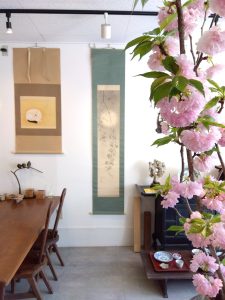
さてこちら名古屋、桜の花もそろそろ終わりになってまいりました。
花びらに隠れて準備を始めていた新緑が次の出番を待っていたかのように顔を出しはじめ、気が付くと至る所に新緑が木々を覆いはじめております。
この季節の変わり目の移ろいが大好きです。ことに春の移ろいは、様々な命の息吹を実感でき、何か新しいことをはじめたくなり、そわそわしてなんだか落ち着きがなくなります(笑)。
新しいことと言えば、新入学の時期ですね。昨日はカラフルなランドセルを背負った、あどけない小学一年生と親御さんたちに遭遇しました。名古屋は昨日今日で公立小中学校の入学式のようです。まだぶかぶかの制服に身を包んで、やや緊張気味に歩いていく姿は微笑ましく、近所のおばちゃんは心の中で頑張れ!とエールを送っておきました。
カラフルなランドセルを見ると、今と昔とでずいぶん変わったものだなと思います。昔は、女の子は赤色、男の子は黒色というのが定番で、それ以外の色のランドセルはとても珍しかったものです。
今はカラーバリエーションもデザインも豊富ですね。近頃の小学生は、テレビや雑誌、インターネットなどの影響なのか、おしゃれにとても敏感なのでしょう。バイカラーやサイドやフタ部分に羽や音符、お花といったモチーフが刺繍されているデザイン性に凝ったものを多数お見かけしました。
ランドセルの歴史は、江戸時代にまでさかのぼります。その始まりは、幕末に輸入され、軍隊で活用されるようになった布製の背のうとされているからです。
国によって様々な通学かばんがありますが、箱型で背負式の「ランドセル」は日本独自のもので、その起源は、明治20年までさかのぼります。
ランドセルの発祥とされているのは、明治10年10月に開校した学習院です。当初から制服が採用されていたため、服装については統一されていた学習院ですが、通学形態については、馬車で通ったり、使用人に荷物を預けたりと様々でした。
しかし、その状況について学習院は、「学校では皆平等、家庭環境を教育の場に持ち込むのはいけない」との理念のもと、「学用品は自分の手でもってくる」べきだとし、8年後の明治18年、子どもたちは、馬車や人力車で通学することや使用人に荷物を預けることを禁止されました。
その際に採用されたのが、背中に添えて両手をあけることができ、持ち運びの利便性が良かった、軍隊用の背のうです。この背のうがオランダ語で”ランセル”と呼ばれていたことから、”ランドセル”という言葉が生まれたのです。
新入生を見るといつも思うのが、カバンがとても重そうなこと。私が中学生の頃、教科書って全部持ち帰って来てたっけ?と記憶は定かではありませんが、今の中学生は約10キロ以上の荷物を持って通学しているのだそうです。カバンはウーバーイーツ?と見間違うくらいの大きさです。
今は教科書+PCもあります。さらにお弁当と水筒、部活の用意。以前、一度背負わせてもらったのですが、重すぎて首、肩、背中にものすごい負荷が・・・これを毎日とは、もはや修行です。押さえられすぎて、背が伸びなくなるんじゃ?と思うほどなのです。もちろん片手では持ち上げられませんでした。
色々な問題があるかと思いますが、少しでも楽しい気持ちで毎日通学してほしいと思うのが親心。少しくらい荷物は減らして、心を軽くして笑顔で学校生活を送ってほしいですね。逆に私は、もう少し重い荷物を持ち上げられるくらい鍛えなくては・・・
ではでは、また。
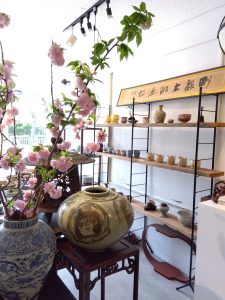
Hello everyone, this is Staff T.
Here in Nagoya, the cherry blossoms are almost at the end of their blooming season.
The fresh greenery, which had been hiding behind the petals and getting ready to appear, has started to show its face as if it was waiting for its next appearance.
I love this seasonal transition. Especially in spring, I can feel the breath of life, and I feel like starting something new, which makes me nervous and somewhat restless (laugh).
Speaking of new things, it is the time of the new school year. Yesterday, I saw some innocent first graders with colorful school bags on their backs and their parents. In Nagoya, it seems that the entrance ceremony for public elementary and junior high schools was held yesterday and today. The sight of these students, still in their overstuffed school uniforms, walking around somewhat nervously made me smile, and in my heart I encouraged them to do their best! I gave them a cheer in my heart.
The colorful school bags reminded me of how much things have changed in the past. In the old days, red was the standard color for girls and black for boys, and school bags in other colors were very rare.
Nowadays, there are many color variations and designs. I think that these days elementary school students are very sensitive to fashion, perhaps due to the influence of TV, magazines, and the Internet. We have seen many bi-colored school bags with elaborate designs with embroidered motifs such as feathers, musical notes, and flowers on the sides and lids.
The history of school bags dates back to the Edo period. The history of school bags dates back to the Edo period (1603-1868), as they were imported at the end of the Edo period (1603-1868) and were used by the military.
While there are various types of school bags in different countries, the box-shaped, backpack-style “randoseru” is unique to Japan, and its origins date back to the 20th year of Meiji Era (1887).
The origin of the randoseru is believed to be the Gakushuin School, which opened in October 1877. From the beginning, uniforms were adopted at Gakushuin, so there was uniformity in clothing, but the form of commuting to school varied, from riding to school in a horse-drawn carriage to leaving luggage in the care of servants.
However, in response to this situation, the Gakushuin decided that children should “bring their own school supplies” based on the principle that “everyone is equal at school and the family environment should not be brought into the educational process.” Eight years later, in 1885, children were prohibited from riding to school in a carriage or rickshaw, or leaving their luggage with servants.
The military backpack was adopted for this purpose, as it was convenient to carry because it was attached to the back and both hands were free. The term “randoseru” (school backpack) was coined from the Dutch word for this backpack, “lansel.
When I see new students, I always think of how heavy their bags look. When I was a junior high school student, did I bring all my textbooks home with me? I am not sure, but I heard that today’s junior high school students carry more than 10 kilograms of luggage to school. My bag is so big that it could be mistaken for an Uber Eats? It is so big that it could be mistaken for an Uber Eats.
Now they also have textbooks plus a PC. Plus lunch, water bottle, and club activities. I was allowed to carry it on my back once before, but it was so heavy that it put a tremendous load on my neck, shoulders, and back…it is now a training exercise to do this every day. It was so heavy that I thought I might not be able to grow taller because of the pressure. It was so heavy that I thought I might not be able to grow taller. Of course, I could not lift it with one hand.
I know there are a lot of problems, but it is a parent’s heart that wants their child to go to school every day with as much joy as possible. I would like them to carry a little less baggage, lighten their hearts, and live their school life with a smile on their faces. On the other hand, I need to train myself to be able to lift a little more heavy baggage…
See you later.
Translated with DeepL.com (free version)
*******************
ご実家の整理やお片付けなどをされている方のご相談などが多くございます。
お片付けなどくれぐれもご無理のないようになさってくださいませ。
風光舎では古美術品や骨董品の他にも絵画や宝石、趣味のお品など様々なジャンルのものを買受しております。
お片付けをされていて、こういうものでもいいのかしらと迷われているものでも、どうぞお気軽にご相談下さいませ。
また風光舎は、出張買取も強化しております。ご近所はもちろん、愛知県内、岐阜県、三重県その他の県へも出張いたします。
まずは、お電話お待ちしております。
愛知県名古屋市千種区姫池通
骨董 買取【古美術 風光舎 名古屋店】
TEL052(734)8444
10:00-18:00 OPEN


